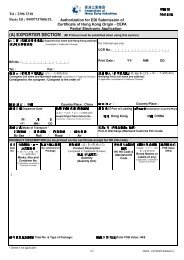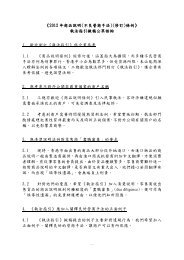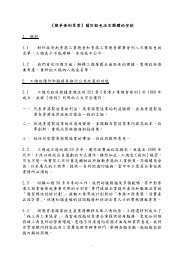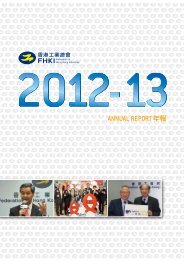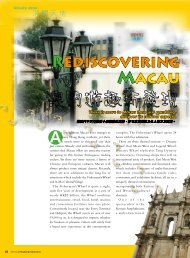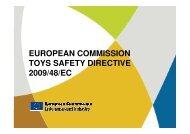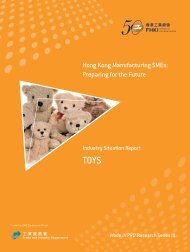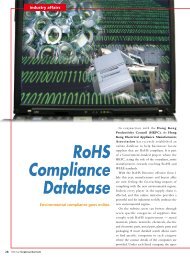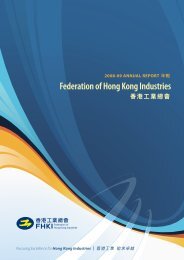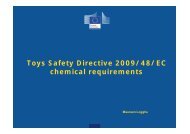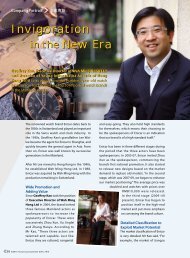Hong Kong Manufacturing SMEs: Preparing for the Future
Hong Kong Manufacturing SMEs: Preparing for the Future
Hong Kong Manufacturing SMEs: Preparing for the Future
- No tags were found...
You also want an ePaper? Increase the reach of your titles
YUMPU automatically turns print PDFs into web optimized ePapers that Google loves.
34<strong>Hong</strong> <strong>Kong</strong> Trade DevelopmentCouncil (November 2007) 83In November 2007, <strong>the</strong> <strong>Hong</strong> <strong>Kong</strong> TradeDevelopment Council surveyed <strong>Hong</strong> <strong>Kong</strong> firmsoperating export processing facilities in <strong>the</strong> PRDon <strong>the</strong> impact of changes in export processingand environmental regulations. A total of 75.1 percent of respondents indicated that <strong>the</strong>ir exportprocessing operations had been affected by <strong>the</strong>changes in export processing rules instituted in2007 and 24.9 per cent indicated <strong>the</strong>ir operationshad not been affected. A total of 44.5 per centindicated that <strong>the</strong> changes had led to an increasein input costs; 30 per cent had to pay customsduty deposits on inputs; and 25.2 per cent saw animpact on <strong>the</strong> availability of inputs from suppliers(note that some companies cited multiple effects).Despite <strong>the</strong> impacts, 78.3 per cent of <strong>the</strong> firmsindicated that <strong>the</strong>y would not consider relocating<strong>the</strong>ir operations from <strong>the</strong> PRD. The main reasonsthat were cited <strong>for</strong> this lack of interest in relocatingout of <strong>the</strong> PRD were cost of relocation (40.9 percent), <strong>the</strong>ir PRD business is still profitable (19.3per cent), <strong>the</strong>y were not aware of o<strong>the</strong>r options(17.5 per cent), relocation to ano<strong>the</strong>r region wouldweaken firm competitiveness (16.6 per cent), ando<strong>the</strong>rs (10.4 per cent).83 See <strong>Hong</strong> <strong>Kong</strong> Trade Development Council, “LatestDevelopment and Strategies of <strong>Hong</strong> <strong>Kong</strong> Companies”Processing Trade Business in <strong>the</strong> Pearl River Delta- SurveyFindings,” 30 January 2008.Overall, <strong>the</strong> outlook of <strong>the</strong> <strong>Hong</strong> <strong>Kong</strong> companieswas mixed. In <strong>the</strong> short-term (one to two years),more respondents felt <strong>the</strong>ir business would seerapid decline (7.4 per cent) than rapid growth (4.8per cent). On <strong>the</strong> o<strong>the</strong>r hand, more respondentsbelieved <strong>the</strong>ir operations would have moderategrowth (34.2 per cent) than moderate decline (28per cent). Similarly, on a three to five year timescale, more respondents believed export processingbusiness would rapidly decline (15.1 per cent)than rapidly grow (7.1 per cent). Slightly morerespondents believed <strong>the</strong>ir operations would exhibitmoderate growth (33.5 per cent) than moderatedecline (31.5 per cent) (see Exhibit 13).Exhibit 13. Outlook <strong>for</strong> <strong>the</strong> Business of <strong>Hong</strong><strong>Kong</strong> Export Processors, November 2007ProspectsShort-term(1-2 years)% of RespondentsMedium-term(3-5 years)% of RespondentsRapid growth 4.8 7.1Moderate growth 34.2 33.5Unchanged 25.6 12.8Moderate decline 28.0 31.5Rapid decline 7.4 15.1Source: <strong>Hong</strong> <strong>Kong</strong> Trade Development Council.Many of <strong>the</strong> respondents indicated <strong>the</strong>ir companieswere taking action to maintain or expand <strong>the</strong>irbusiness in <strong>the</strong> PRD. A total of 42.4 per centindicated that <strong>the</strong>y would look to increase sales inChina’s domestic market (presumably <strong>for</strong>egoing<strong>the</strong> tariff breaks af<strong>for</strong>ded to export processingproduction); 42.1 per cent were looking to increasedomestic sourcing of inputs (so <strong>the</strong>y would not haveto pay import tariffs on <strong>the</strong> inputs); 34.7 per centwould consider changing from an export-processingoperation to a <strong>for</strong>eign-invested enterprise (<strong>the</strong>reby<strong>for</strong>egoing <strong>the</strong> advantages of export processingwhile also avoiding <strong>the</strong> restrictions associated wi<strong>the</strong>xport processing); 22.8 per cent indicated that <strong>the</strong>ywould increase capital investment (presumably toautomate production and to improve environmentalper<strong>for</strong>mance); and 16.3 per cent would investin green production (to improve environmental



